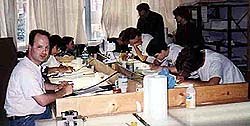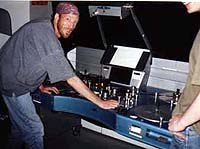The features of the Quickdraw Animation Society (QAS), a non-profit, artist-run, film production co-op located in Calgary, Alberta, Canada, are discussed by long time member Don Filipchuk.

The Quickdraw Animation Society (QAS) is a non-profit, artist-run, film production co-op located in Calgary, Alberta, Canada. QAS is dedicated to providing the independent animator inexpensive access to equipment, resources, and training to create their own animated productions. QAS also provides a public forum to access and appreciate all forms and styles of animation.QAS (pronounced "kwahs") is a place where folks can come and enjoy, learn, and more importantly, create animation. The Society was originally established in 1984 as a centre for animation appreciation, and has evolved into the production centre it is today.
As a non-profit society, Quickdraw is governed by a volunteer Board of Directors. In addition to engaging a small part-time staff to manage operations, production equipment, and programming, such as the recent "Screamin' Screening," QAS provides extensive resources to the independent animator:
- four production rooms, including two, soon to be three, full Oxberry animation stands (one fully mechanized), and one 2D animation stand suitable for filming simple 2D, backlit, and other experimental animation.
- an extensive animation library filled with video tapes, laser disks, books, and magazines.
- a large classroom/work area for presenting classes and workshops.
- a screening room, shared with our neighboring video production cooperative EMMEDIA.
- a computer room featuring simple yet essential digital tools, such as a scanner, digital tape recorder, and fast internet access for email animation research.
- basic services like a fridge, coffee maker, photocopier and fax machine.
- a film editing room featuring various editing and splicing equipment and an Intercine flatbed 16/35 mm film editing table.
- basic supplies essential for pursuing classical and experimental animation, such as peg bars, paper and film stock.
With an eye to the ever-present issue of the convergence of traditional film and new digital technologies, QAS is taking its first "baby steps" into the world of digital animation. In addition to two analog video pencil test machines, QAS will soon have two computer-based pencil test machines set up: one a time-tested workhorse Amiga-based "Take 2" system, and the other, a more expandable Windows NT-based animation pencil-test/digital ink-and-paint system.

Animation Classes and Workshops
Animation classes and workshops are essential to help the independent producer acquire the required skills to produce an animated film. From classical training in basic animation principles such as storytelling, timing, motion concepts, squash-and-stretch and animation history, to learning to exploit the full capabilities of the Oxberry animation camera stand using pans, rotation, zooms, cross-dissolves and the like, to instruction on film processing and editing techniques, QAS currently runs beginner to advanced animation classes. Member Kevin D.A. Kurytnik, an animator and producer, brings seven years of animation teaching experience to his classes, which are targeted to the beginning, intermediate, or experienced animator. Quick-Kids classes, held in the summer and during other breaks in the regular school schedule are taught by animation instructor Cyndy Ward. In addition to these classes designed for kids ages 9-14, this summer QAS is also offering a class especially for teens, in which QAS encourages an excitement and appreciation for animation in the young people.
The Quickdraw Animation Library
Quickdraw is home to an extensive animation library. Assembled over many years, this dedicated space is filled with a large circulating video tape collection, which includes all kinds of animation from around the world. A large selection of video disks (featuring many fantastic box-sets) is also available -- perfect for "single framing" through animation to learn the techniques used to achieve specific effects. Reference material, such as the rare Edweard Muybridge motion studies, books covering historical, educational, contemporary, and critical aspects of animation theory, and a broad selection of current animation magazines, abounds, which is ideal for the research and enjoyment of animation. Reference material covering all types of animation is available, from classical to computer, to experimental techniques, such as puppet/clay animation, and under-the-camera animation, like paint on glass, paper cut-outs, back-lit plastercine, sand, and cameraless animation techniques. Examples of all types of animation are available as well. The library is also home to a non-circulating video archive of works created by QAS members.
Information about like-minded places is handy, especially information and newsletters from other artist-run centres -- locally, nationally and internationally. A broad selection of such current animation periodicals is housed and available at QAS.The library is also a complete source of information describing the nuts and bolts of producing an animated film, including grant application forms, job opportunities, and festival information and entry forms.

The Hometown Screamin' Screening
On the event of QAS' Fifteenth Anniversary, on May 14 and 15, 1999, Quickdraw held a curated screening of animated films created at QAS in Calgary and the Atlantic Filmmakers Cooperative (AFCOOP) in Halifax, Nova Scotia. The screening was designed to highlight the similarities and differences of works created in centres located almost completely across Canada: from the growing cosmopolitan resource-rich centre of Calgary, located in the western prairie, to the picturesque and historical maritime city of Halifax, located on Canada's Atlantic coast.
Thanks to the assistance of the Canada Council of the Arts, four filmmakers from Halifax were able to attend the screenings and provide artists presentations to accompany their works. Over 30 animated and live-action short films were shown over two nights; in addition to talks by QAS animators Trevor Mahovsky and Richard Reeves, and Halifax artists Jim MacSwain, Helen Hill and Helen Braedin. During their talks, the artists described their varied influences and activities: from the many influences that led Jim MacSwain to choose collage animation as his presentation style; to the influence the works of Norman McLaren had on the direction of Richard Reeves' animation; to the cel animation and low-tech, yet complex, mechanically animated installations of Trevor Mahovsky that by their construction and nature, draw the viewer into the presentation; to the description of Helen Hill's ongoing endeavors to learn the many techniques and almost mysterious craft of hand-processing and developing of film.

Cameraless Workshop by Richard Reeves
On Saturday, May 15 and Sunday, May 16, fifteen animators created cameraless animation by scratching, drawing, colouring, bleaching, painting, photocopying, pasting, and otherwise impressing sound and image onto 35mm film stock, under the tutelage of award-winning cameraless animator Richard Reeves. The works, mostly non-narrative imagery and hand-drawn sound, exhibited the broad range of influences and creative directions of the participants. The techniques used were as numerous as the participants and included drawing scenes of a frenetic hockey game, photocopying images onto film, taping and decorating 16mm film frames onto the 35mm stock, scratching images of an ostrich laying an egg, impressing abstract and unusual textures onto the film by rubbing against corrugated cardboard, and impressing a small stamp carved from an eraser! Many animators, inspired by the Saturday night screening of AFCOOP works, returned to QAS to work on their animated films through the night. The final product was spliced together and screened at Quickdraw around 11:30 pm on Sunday evening, to the delight of the workshop participants and guests who came to enjoy these singular animated visions!

Acknowledgments
QAS funding comes from membership and programming fees and the following funders: The Canada Council for the Arts, The Alberta Foundation for the Arts, The Calgary Regional Arts Foundation and the National Film Board of Canada.QAS is located at:# 201, 351 - 11th Avenue S.W.Calgary, AlbertaCanada T2R 0C7http://www.awn.com/qasTel: (403) 261-5767Fax: (403) 261-5644Don Filipchuk has been involved with QAS since 1992, taking classes, producing newsletters, serving on the Board of Directors, producing short animated works. Plus, he recently led his first QAS workshop; an animation "Web Jam," a portion of which is now available for viewing on the QAS website. His first completed animated film, Scuba Siv, has been screened at film festivals across North America, including Philadelphia, Chicago, Victoria and Halifax. Don is also the past president and has been the QAS webmaster since 1996.







